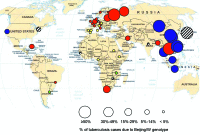Beijing/W genotype Mycobacterium tuberculosis and drug resistance
- PMID: 16704829
- PMCID: PMC3374453
- DOI: 10.3201/eid1205.050400
Beijing/W genotype Mycobacterium tuberculosis and drug resistance
Abstract
Beijing/W genotype Mycobacterium tuberculosis is widespread, may be increasing, and may have a predilection for drug resistance. Individual-level data on >29,000 patients from 49 studies in 35 countries were combined to assess the Beijing genotype's prevalence worldwide, trends over time and with age, and associations with drug resistance. We found 4 patterns for Beijing/W genotype tuberculosis (TB): 1) endemic, not associated with drug resistance (high level in most of East Asia, lower level in parts of the United States); 2) epidemic, associated with drug resistance (high level in Cuba, the former Soviet Union, Vietnam, and South Africa, lower level in parts of Western Europe); 3) epidemic but drug sensitive (Malawi, Argentina); and 4) very low level or absent (parts of Europe, Africa). This study confirms that Beijing/W genotype TB is an emerging pathogen in several areas and a predominant endemic strain in others; it is frequently associated with drug resistance.
Figures

References
-
- Filliol I, Driscoll JR, van Soolingen D, Kreiswith BN, Kremer K, Valetudie G, et al. Snapshot of moving and expanding clones of Mycobacterium tuberculosis and their global distribution assessed by spoligotyping in an international study. J Clin Microbiol. 2003;41:1963–70. 10.1128/JCM.41.5.1963-1970.2003 - DOI - PMC - PubMed
Publication types
MeSH terms
Substances
LinkOut - more resources
Full Text Sources
Medical
